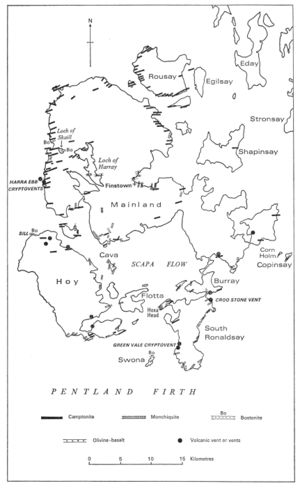Volcanic breccias and vents and associated mineralisation, Orkney
| Mykura, W. 1976. British regional geology: Orkney and Shetland. Edinburgh, Her Majesty's Stationery Office. |
Introduction

Several small volcanic vents have been mapped in the area which extends from south-eastern Hoy and South Ronaldsay north-eastward to Deerness in south-east Mainland (P915590). There is also a cluster of vents and volcanic plugs in northern Hoy. In addition, a number of small crypto-vents have recently been recorded at Harra Ebb on the west coast of Mainland.
The breccia-vents in south-east Orkney consist of two types:
- 1. Those composed largely of clasts of basic igneous material (usually monchiquite), set in a matrix of basic tuff;
- 2. those consisting principally of angular fragments and blocks of flagstone and sandstone set in a matrix of ground-up sediment which in some vents contains some small rounded lapilli of basic igneous material.
The former are always small (less than 20 m in diameter) and fairly regular in outline. They usually contain some clasts of corroded and partially absorbed sediment. The latter generally have an irregular shape and vary greatly in size. The most interesting of these vents is the irregular sediment-breccia exposed on the foreshore at Croo Stone at the north-east corner of South Ronaldsay. This measures 160 m from north to south and about 90 m from east to west and has dykes of monchiquite (locally up to 4 m wide) intruded both along its margin and within the vent. Another example is the small but spectacular vent seen on the cliffs west of Green Vale on the west coast of the same island. This has a carbonate-rich matrix of comminuted sediment but has no monchiquite dykes directly connected with it. Most of the sediment-filled vents of this area, however, have some monchiquite associated with them and it must be assumed that their formation was in some way connected with the uprising of monchiquitic magma. It is probable, that, like the sediment breccias of east Shetland, the vents were formed by a process of gas fluxion and they may never have extended to the surface. Flett has suggested that the gas (mainly steam) may have been generated when the ascending magma met with local concentrations of ground water.
At Harra Ebb near Yesnaby (West Mainland) (P915590) there are six small oval-shaped cryptovents, none of which exceed 11 m in diameter, and one fissure vent which can be intermittently traced for a distance of 50 m. All these contain only angular to subrounded sandstone clasts of varying size, set in a matrix of comminuted carbonate-rich sandstone. Though a camptonite dyke crosses the area within which these vents occur, there is no direct evidence to connect them with the camptonite magma. Irregular masses of sediment breccia and narrow belts of fissure breccia, usually associated with small faults and monoclinal flexures, have been found farther south on the West Mainland coast and elsewhere in Orkney. In some areas these fissure breccias contain galena or chalcopyrite.
Five volcanic orifices have been recorded near Breibister in northern Hoy. These comprise two plugs formed entirely of basalt, two vents which contain both tuff and basaltic material and one vent which consists entirely of breccia. All these vents and plugs cut the Upper Stromness Flags which are here overlain by the Hoy Volcanic Rocks. As no vents have been recorded in the Hoy Sandstone that crops out a short distance to the south it has been assumed that these orifices were the feeders for the overlying Hoy lavas and tuffs.